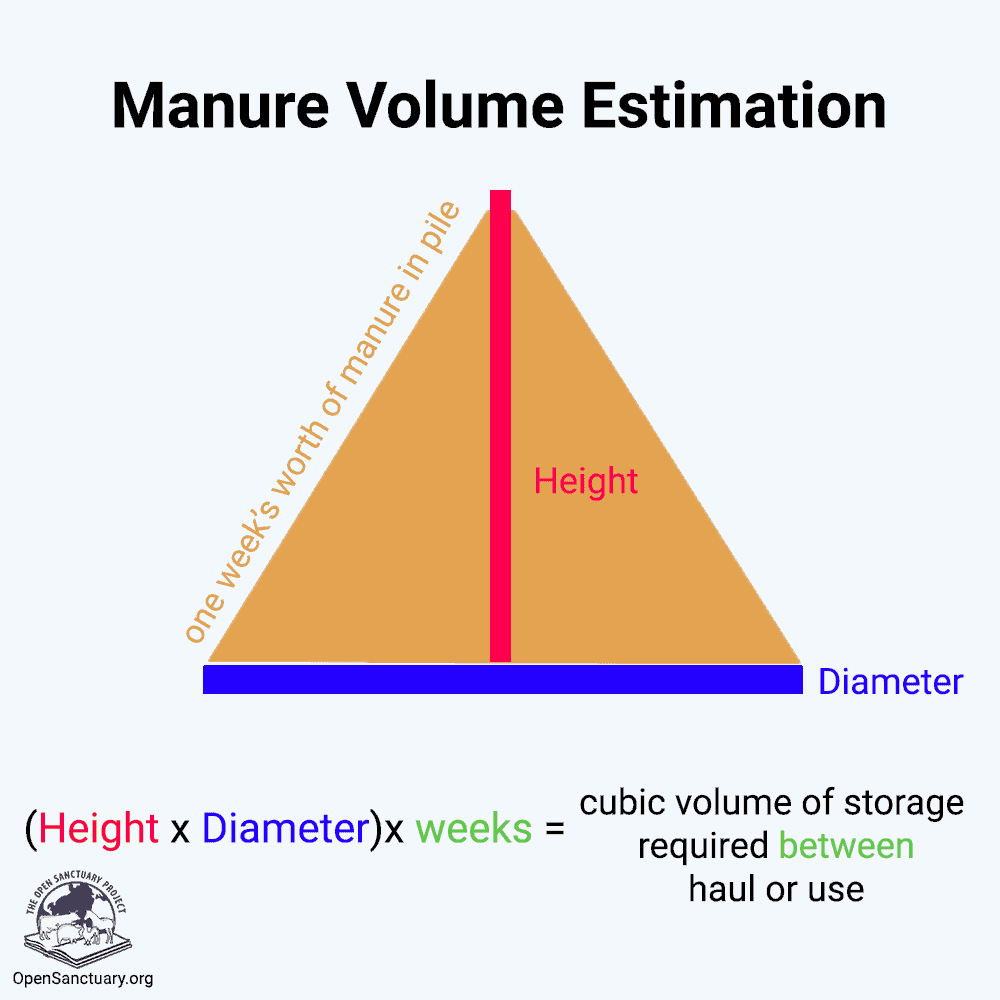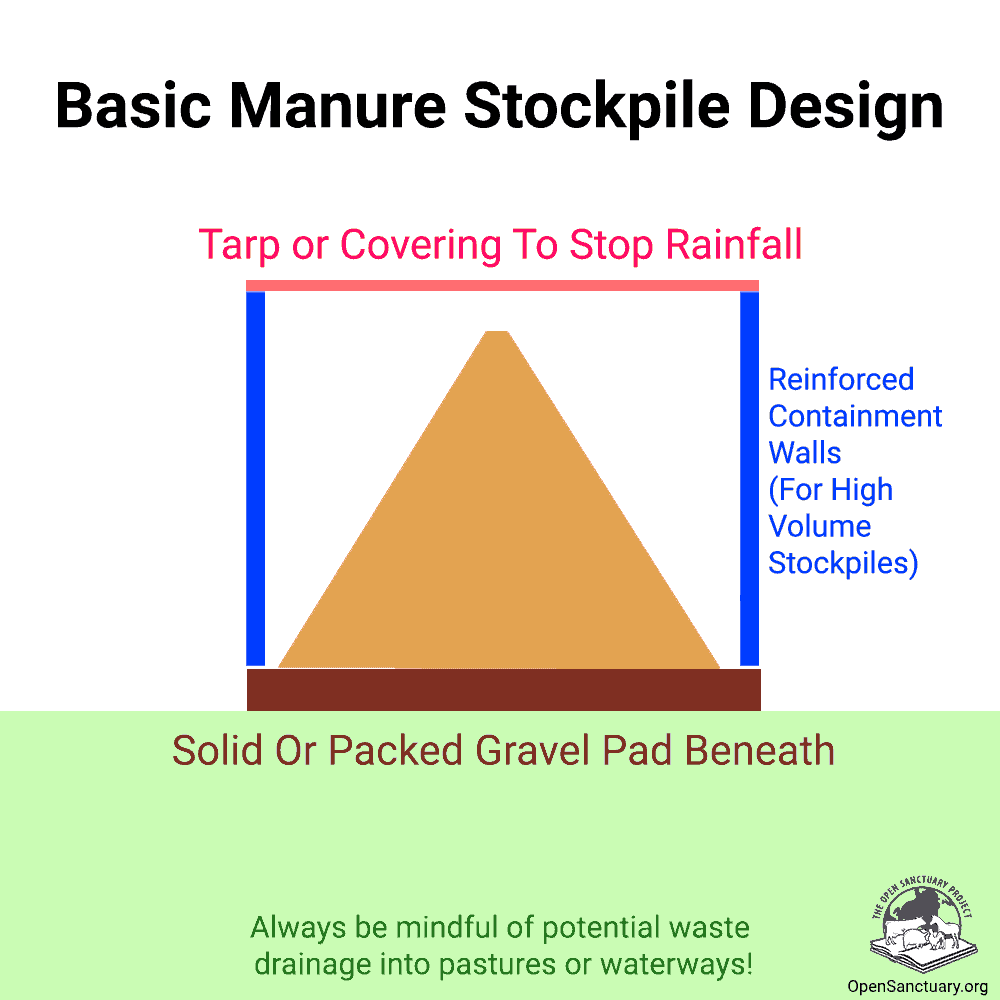
Sometimes operating an animal sanctuary stinks…literally! So what are you to do with all that poo? This resource covers several ways to manage the manure at your sanctuary and includes a guide to creating a manure management plan that will best suit the needs of your sanctuary. Manure management is an important aspect of sanctuary management, in addition to keeping your residents safe and healthy. Poor sanitation can lead to the spread of disease (on top of the smell factor)!
How a sanctuary decides to manage manure will depend on their Philosophy of Care, but leaving manure unmanaged will very quickly lead to a smelly sanctuary with unhealthy and unhappy residents, and likely unhappy neighbors too!
On-Pasture Manure Management
On-Pasture Manure Management is probably the most low maintenance manure management technique for any grazing or browsing residents. This simply involves keeping residents on well-maintained pastures by using temporary fencing and moving residents to new grazing areas. However, many sanctuaries may not have adequate space to choose this option, and when done incorrectly, this can lead to the spread of disease and intestinal parasites. Let’s look a little closer at what this technique, often called “rotational grazing”, entails:
Rotational grazing is fairly self-explanatory; you rotate residents between different grazing areas. Dividing a pasture into 4 smaller pastures is recommended, but a pasture can also be divided into 2 smaller grazing areas. It is recommended that residents be moved when the grass’ height is down to about 2-3 inches (5-7.6 centimeters), and returned when the grass’ height is about 8 inches (20 centimeters). Placing multiple water and food resources around the pasture will help ensure manure is more evenly distributed.
If the pasture is big enough to handle the needs of the residents on it, you should be able to spread manure across the pasture and break it up with a rake or pitchfork, though some have suggested riding over it with a riding mower, either using the mower directly or by dragging a harrowA tool which breaks apart clumps of waste, soil, or plant life by being dragged through areas, particularly pastures. with a mower or tractor (Do not attempt this while residents are in the pasture with you). This allows the manure to dry out, which reduces fly breeding and intestinal parasites.
If you decide to utilize this technique at your sanctuary, it is critical that manure not be allowed to build up on the pasture. If the size of the pasture is limited, or if there is an intestinal parasite problem, collect the manure and stockpile or compost it.
So what is the difference between stockpiling and composting?
Stockpiling Versus Composting
Composting
The basic goal of composting is to achieve a balance of carbon, nitrogen, oxygen, and moisture through adding the right mix of ingredients with regular aeration. Doing this creates heat, and the heat accelerates the breakdown process. There are three techniques of composting: hot, warm and cool. In addition, there are several systems for sanctuaries to contain the compost, including static piles, windrows, and three-bin units. For those who have a small tractor or skid steer with a bucket loader at their disposal, these can be used for turning and moving compost. Of course, many sanctuaries do not have access to this machinery. In this care, sanctuaries can still set up a small-scale composting system that can be managed without machines.
An added bonus to composting is it can prevent the spread of intestinal parasites if it reaches a certain temperature. composted manure is also lower in soluble salts than raw manure, so it will not burn any plants that are present on the pasture if you plan to spread the manure. Compost is also often pH-neutral, meaning it is less likely to cause nutrient imbalances in the plant life in the pasture.
Stockpiling
Stockpiling manure simply means storing it until you decide to spread it or get rid of it. In order to stockpile manure, you must ensure you have a solid pad to store it on, and you must also have proper coverage for the stockpile. Allowing manure piles to be rained on can cause environmental issues as the manure’s nutrients may contaminate local water supplies. If you dispose of manure in ditches or other out of the way places without proper flooring and rain cover, you also risk water contamination. Sometimes gravel in a packed pad works well, or stone dust is used.
If you have many residents, or plan to stockpile the manure for a lengthy time period, consider adding reinforced containment walls. You want stockpiled manure to stay dry; therefore, some form of roof is necessary for a stockpile, even if the “roof” is only a tarp secured around the edges. The stockpiling area needs to have a slope of 1 to 3 percent so runoff from the roof and any leaching can be directed through a grass buffer.
Spreading Stockpiled Manure
You can purchase a manure spreader to distribute manure evenly throughout the pastures. Most parasites will not survive a long period of very hard freeze or extreme hot, dry weather. After spreading, harrow the pastures to break up manure clumps and expose as much area as possible to the elements. It is important to keep residents off the pasture for at least several weeks to allow parasites to die off.
If spreading is not a viable option for your sanctuary, you can also opt to have wastes hauled away.
Hauling Away Manure
If your residents produce more manure than you can spread, removal is an option. In this case, you will still need a stockpiling area to store manure until it can be hauled away.
Some sanctuaries have opted to give compost away to community gardeners or sell bags of compost. This is a philosophical choice that many sanctuaries have decided against, wishing to distance themselves from any possible interpretation of exploitation of animals.
Another option is to take manure to the landfill, but it is less than ideal: At a landfill, the manure’s nutrients have the potential to leach into waterways and groundwater and take up a lot of space. Additionally, not all trash handlers will accept animal waste in their regular collection service.
Manure Digesters: Options For The Future
Another exciting and more eco-friendly option for the future are anaerobic digesters. Anaerobic digestion is a natural process that creates biogas. Anaerobic digesters are closed systems that harness this natural process to produce biogas and other useful co-products. These systems also reduce odors, pathogens and waste. While this is far from an inexpensive and accessible option for most sanctuaries, we hope to see it become a more financially friendly option in the future. At the moment, these are generally used on large-scale exploitive farming operations.
As you can see, there is no easy way to make poo magically disappear, but there are options that may suit your sanctuaries needs. Now that we have covered different strategies of manure management, you can work on developing a manure management plan for your sanctuary!
Getting Started With Your Sanctuary’s Manure Management Plan
The first step in creating a manure management plan is identifying and existing potential sources of pollution at your sanctuary. Draw a map of your property showing locations of all buildings, pastures, septic systems, manure storage areas, and then all wetlands, property lines, and, if you grow food at your sanctuary for residents, what areas you plant.
The second step is to mark any areas you see as potential problems or relevant to drainage on your sanctuary’s property.
For example:
- Is your compost or stockpile simply on the ground?
- Is it elevated or open in such a way that water drains from the pile down into the ground or down a hill?
- Is manure being stored near any wells?
- What path does water take when it rains?
- Where does the water from building roofs go?
- Are there low-lying areas, wet, soggy areas, or drainage or waterway areas on sanctuary property?
- What type of soil does your sanctuary property have?
- Do you have compacted soil around resident housing and other buildings?
Overcrowding of residents can lead to greater risk of water contamination, disease outbreak, and unhappy residents. This is one reason why recognizing your sanctuary’s capacity for responsible care is so important.
Now we are on to our third round of questions, concerning pastures and paddocks:
- Do you rotate or limit pasture use?
- Are any of the residents standing in manure or mud?
- Are residents able to walk over and around stream banks?
- Is there proper drainage in the paddocks? Does water flow through the paddocks at any places?
- Do you have a system for spreading manure in pastures or removing manure from concentrated areas, slopes, and near drainage passages?
- Have you noticed brown water running off bare pasture?
Fourth, you will need to review your current manure management practices.
- Does your sanctuary have a basic manure management plan?
- How is manure stored?
- Is the storage area adequate to handle generation until the manure can be utilized or disposed of?
- Is storage easily accessible?
- Is the storage area covered?
- Have you noticed a manure odor problem at your sanctuary?
- Do you have high populations of flies and/or mice and rats?
- If you are utilizing the manure, is is being used in an environmentally-friendly way?
Now that you have reviewed your property and current practices, you can begin to develop a written plan for manure management!
Your plan should include the following information:
- The amount of manure and bedding that is generated annually.
- Methods of manure handling and collection including tools and equipment and areas of collection (ex. Indoor and outdoor living and activity spaces)
- The size and location of storage or composting facilities.
- What methods will be used to prevent drainage through paddocks and pastures and storage areas.
- Records or dates of land-application (if spreading), monitoring compost, and if the manure is taken off-site.
- If you plan to spread manure on to pasture or gardens for residents, a nutrient analysis of manure and soil analysis can be helpful.
Here’s a table of some residents of different sizes and their general manure storage requirements:
| Species | Weight (Pounds) | Weight (Kilograms) | Storage (Cubic Feet per month) | Storage (Cubic Meters per month) |
|---|---|---|---|---|
| CowWhile "cow" can be defined to refer exclusively to female cattle, at The Open Sanctuary Project we refer to domesticated cattle of all ages and sexes as "cows." | 1000 | 453.59 | 28.5 | .81 |
| Cow | 500 | 226.8 | 14.4 | .4 |
| Horse | 1000 | 453.59 | 24.3 | .69 |
| Sheep | 100 | 45.36 | 1.8 | .06 |
| Goat | 50 | 22.68 | .9 | .03 |
| Llama | 330 | 149.69 | 6.93 | .2 |
| Pig | 65 | 29.48 | 2.1 | .06 |
| Pig | 150 | 68.04 | 4.8 | .14 |
| Pig | 375 | 170.1 | 10.8 | .31 |
| Chicken (Non-Large BreedA domesticated animal breed that has not been specifically engineered to grow as quickly as possible for the purpose of human consumption. In resources at The Open Sanctuary Project, "Heritage" breeds of turkeys, for instance, are "non-large breed", even if they are physically quite big.) | 4 | 1.81 | .11 | .003 |
Source: USDAThe United States Department of Agriculture, a government department that oversees agriculture and farmed animals. Natural Resources Conservation Service, Lynden Field Office, Lynden, WA.
To estimate a more precise amount of manure generated at your sanctuary, collect manure and bedding for one week and store it in a cone-shaped pile. Measure the height and diameter of the pile. Multiply this by the number of weeks you estimate will be required to store the manure before it is used or hauled away. This will enable you to determine the volume of manure generated at your sanctuary and estimate your storage needs!
Does your sanctuary have an innovative way of dealing with manure? Please let us know. We are constantly looking for ways to improve our resources in order to provide the best possible information for sanctuaries!
Ready to learn more about manure? Check out our advanced manure management resource here!
SOURCES:
4 Manure Management Options for Your Farm | Hobby Farms (Non-Compassionate Source)
Learning About Biogas Recovery | EPA (Non-Compassionate Source)
Manure Management For Small And Hobby Farms | Northwest Recycling Council (Non-Compassionate Source)
If a source includes the (Non-Compassionate Source) tag, it means that we do not endorse that particular source’s views about animals, even if some of their insights are valuable from a care perspective. See a more detailed explanation here.









